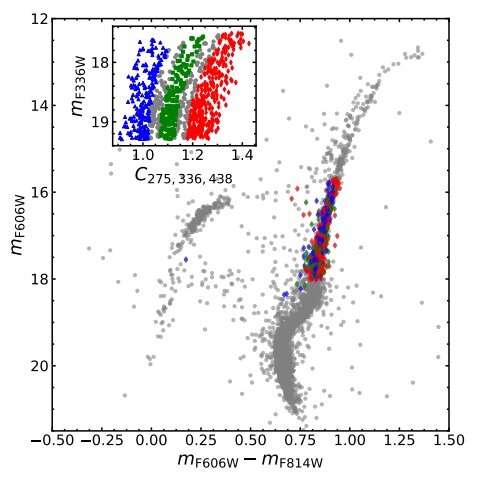December 23, 2019 report
Astronomers study peculiar kinematics of multiple stellar populations in Messier 80

Tomasz Nowakowski
astronomy writer

Using the Very Large Telescope (VLT) and the Hubble Space Telescope (HST), astronomers have investigated one of the Milky Way's globular clusters, Messier 80. The new study concentrated on peculiar kinematics of Messier 80's multiple stellar population and provides important information about the cluster's formation and evolution. The research was published December 12 on arXiv.org.
Observations of globular clusters (GCs) in the Milky Way galaxy are of high importance for astronomers as they are among the oldest objects in the universe. Therefore, they are perceived as natural laboratories for the study of stellar evolution processes.
Located some 32,600 light years away in the constellation Scorpius, Messier 80 (also known as M80 or NGC 6093) is a galactic globular cluster containing several hundred thousand stars. The cluster is known to host multiple stellar populations showcasing differences in their light-element abundances like carbon, nitrogen or oxygen.
Previous observations of Messier 80 have shown that its three stellar populations not only vary in their light-element abundances but also appear to be unusually distributed. It was found that the primordial population is more centrally concentrated than the intermediate population (in terms of nitrogen enrichment), which is more centrally concentrated than the extreme population.
Such distribution makes Messier 80 atypical among other GCs in the Milky Way, and suggests complex formation and evolutionary history. In order to better understand how this cluster formed and evolved, a team of astronomers led by Sebastian Kamann of Liverpool John Moores University, U.K., investigated its internal kinematics. For this purpose, they analyzed spectroscopic data from VLT's Multi Unit Spectroscopic Explorer (MUSE) and photometry from HST.
"In this work, we study the kinematics of the populations and investigate if they hold further clues on the dynamical evolution of NGC 6093. With this aim, we combine the photometry of Dalessandro et al. (2018a) with MUSE (Bacon et al. 2010) integral field spectroscopy," the astronomers wrote in the paper.
The researchers derived radial velocities of a sufficiently large sample of stars to conduct kinematic analysis for each of the three stellar populations. They found that all three populations are rotating and have consistent (projected) rotation axis orientations. However, the extreme population (with the highest nitrogen enrichment) turns out to have a higher projected rotation velocity than the remaining two.
According to the authors of the paper, the populations of Messier 80 may differ in their intrinsic rotation properties and may have different angular momenta. This hypothesis would explain the observed kinematics. However, given that no process is known that could induce such variations during the evolution of a cluster, the astronomers assume that they were imprinted during the formation of Messier 80.
"Using axisymmetric Jeans models, we show that these findings can be explained from the radial distributions of the populations if they possess different angular momenta. Our findings suggest that the populations formed with primordial kinematical differences," the researchers explained.
In concluding remarks, it was noted that the presented scenario needs further investigation. For instance, high-resolution spectroscopic observations would provide more detailed information about the kinematics and the chemistry of Messier 80's stellar populations.
Written for you by our author —this article is the result of careful human work. We rely on readers like you to keep independent science journalism alive. If this reporting matters to you, please consider a (especially monthly). You'll get an ad-free account as a thank-you.
More information: The peculiar kinematics of the multiple populations in the globular cluster Messier 80 (NGC 6093), arXiv:1912.06158 [astro-ph.SR]
© 2019 Science X Network





















